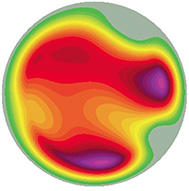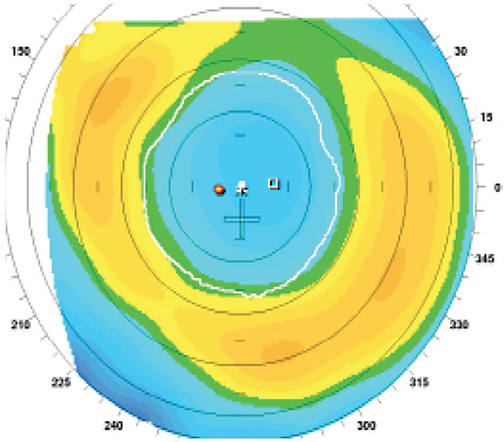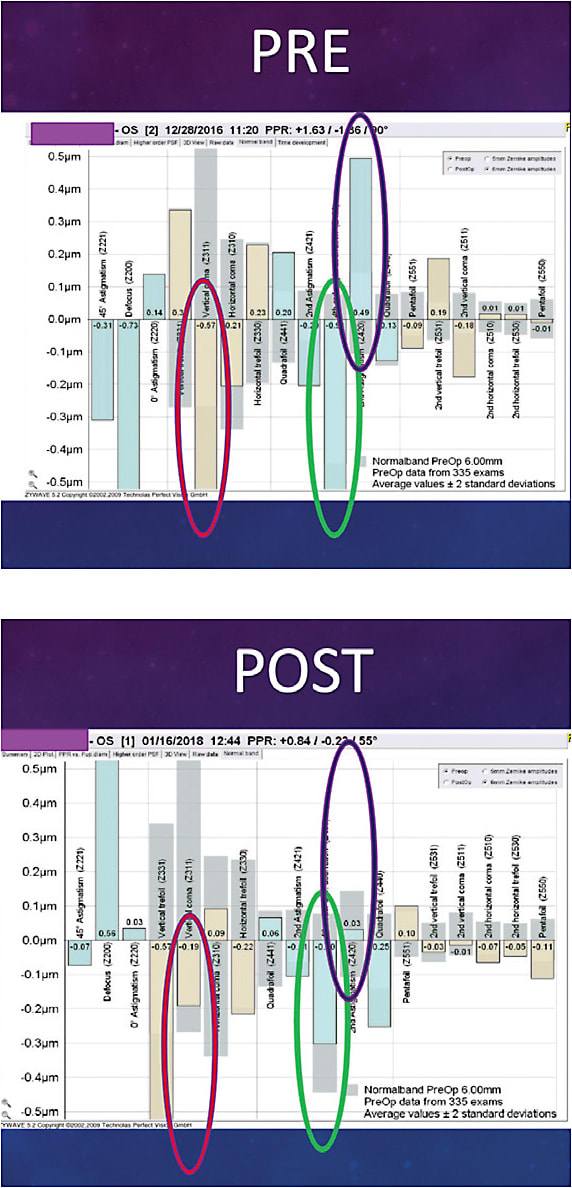Most corneas contain topographic irregularities. In fact, these topographic irregularities are what produce most of the higher-order aberrations of the eye. Thus, removing them from the refractive surgery equation alters the manifest refraction (MRx) treatment that should be placed on the eye. (See: “The Topo-Guided Laser: My Experience,” below.) The result: Fewer patients reaching 20/20 and 20/15 uncorrected visual acuity (UCVA), and the possibility of a flipped astigmatic axis. To rectify this, the Phoricides Analytic Engine was created. Here, I discuss its features and accuracy.
Geographic Imaging
The software uses geographic imaging to analyze the topography ablation map to aid the surgeon in determining what refractive effect the topography treatment will have on the sphere and cylinder that should be treated.
Additionally, it gathers anterior cylinder information from a Placido disc and a Scheimpflug device, along with posterior cylinder and magnitude. The software then calculates any lenticular astigmatism and uses vector mathematics and algorithms to derive the optimal sphere, cylinder, and axis that should be treated.
Colored Arrow Representation
The Phoricides Analytic Engine diagnostic software also gives a colored arrow representation of all the refractive vectors at play in the eye, so the surgeon understands why the MRx may differ from the measured anterior corneal cylinder. How, what, when, why, and where are all provided by this technology.
Accuracy
Theoretical,1 retrospective,2,3 and prospective4 studies have shown that the software enables surgeons to provide better postoperative vision versus using MRx or tomography-modified refraction (i.e., treating off the measured anterior corneal astigmatism).
In fact, in a recently completed prospective study3 using the Phoricides Analytic Engine software, 100% of eyes treated at 4 U.S. centers achieved 20/20 UCVA at 3 months postop, and 89% achieved 20/15 UCVA. Additionally, 99% of eyes showed ≤ 0.25 D residual astigmatism at 3 months. There were also statistically significant improvements in glare, halos, and night-time driving in patients.
Case in point: A patient has a refraction of -0.50 D +1.00 D x 14. Now, imagine you are only going to treat the astigmatism. You plan plano +1.00 D x 14. You can see the treatment will remove 16 μm of tissue in the areas in purple (Figure 1). Following this treatment, do you expect the MRx to still be -0.50 D +1.00 x 14? No, of course not. You removed 16 μm of tissue from two areas of the cornea.

Now, consider a topography-guided treatment (Figure 2). This is a purely topographic treatment. The areas in purple (raised topographic irregularities or “taluses”) will be ablated, 32 μm of tissue each. After this topographic treatment, would you expect the MRx to remain the same? No, you would not. This is why treating MRx without taking topographical irregularities into account leads to less-than-optimal results.

THE TOPO-GUIDED LASER: MY EXPERIENCE
In my experience, early excimer lasers often created small optical zone treatments and had poor blend zones surrounding this. Additionally, eye trackers were either slow or non-existent. As a result, a small number of patients ended up with disabling night glare due to the steep topographic slope transitioning rapidly from the flattened treatment zone up to the untreated, surrounding cornea. When the pupil dilated, the steep transition zone created significant glare (Figure 3). Other patients had off-centered ablations, which created a host of challenging topographic irregularities that generated a multitude of higher-order aberrations.

Prior to topography-guided treatments, I remember there were few ways to help these patients other than to prescribe RGP contact lenses. Topography-guided treatments offered a ray of hope for these eyes, improving the topography of the corneas and, in turn, the vision (Figure 4 and 5).


The FDA approved the first topography-guided LASIK procedure in 2013 for Alcon’s WaveLight Allegretto and Wave Eye-Q Excimer Laser. Contoura Vision, the next laser, received FDA approval in 2016. The Phoricides Analytic Engine software can be used with the EX500 laser running Contoura.
A Powerful Tool
Topography-guided LASIK is a powerful tool in the refractive surgeon’s arsenal. It is, however, more complex than traditional treatments, as it treats topographic irregularities (taluses) that affect the MRx.
In addition, to achieve perfection, one must consider the posterior corneal astigmatism and any lenticular astigmatism contributions that will remain after a corneal excimer laser treatment. Surgeons may be treating the cornea, but they are not altering the posterior corneal curvature or the refractive properties of the lens. Fortunately, software now exists to do all this.
In the future, will artificial intelligence be applied to further increase the accuracy of the software? Will machine learning use differential geometry to better predict the refractive effect of removing complex topographic slopes on the cornea? These advances would be especially helpful for the off-label repair of complex eyes. The result would be patients who have exceptional postoperative vision and happy surgeons! Stay tuned… CP
References:
- Stulting RD, Durrie DS, Potvin RJ, et al. Topography-guided refractive astigmatism outcomes: predictions comparing three different programming methods. Clin Ophthalmol. 2020;14:1091-1100.
- Lobanoff M, Stonecipher K, Tooma T, Wexler S, Potvin R. Clinical outcomes after topography-guided LASIK: comparing results based on a new topography analysis algorithm with those based on manifest refraction. J Cataract Refract Surg. 2020;46(6):814-819.
- Brunson PB, Mann Ii PM, Mann PM, Potvin R. Clinical outcomes after topography-guided refractive surgery in eyes with myopia and astigmatism — comparing results with new planning software to those obtained using the manifest refraction. Clin Ophthalmol. 2020;14:3975-3982.
- Stulting RD, Lobanoff M, Mann PM 2nd, Wexler S, Stonecipher K, Potvin R. Clinical and refractive outcomes after topography-guided refractive surgery planned using Phorcides surgery planning software. J Cataract Refract Surg. Published online Feb 10, 2022.









